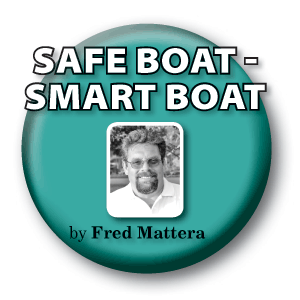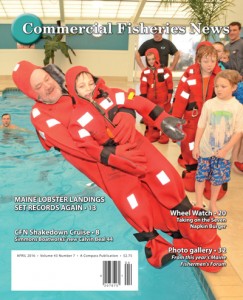One aspect of the drills I often conduct on fishing vessels, has led me to use a DVD developed by the Southwest Center for Agricultural Health, Injury Prevention, and Education www.swagcenter.org titled “Communication, Navigation, and Mayday.”
This really is an awesome tool – showing animated vessels performing and describing the rules of the road.
It is an interactive video that demonstrates the procedures and followed by a review, asking questions of the viewer.

A qualified Coast Guard-approved marine drill instructor, Fred Mattera of Point Judith, RI is the owner/president of North East Safety Training Co. (NESTCo), which conducts fishing vessel drills and inspections and basic safety training workshops.
To-date I have used this video approximately 100 times and only four vessel crews have answered all the questions correctly.
The fact is, we have all become so reliant on our electronics – GPS, radars, ARPA system chartplotters and, for vessels over 65,’ AIS – to identify and avoid possible collisions we sometime forget basic seamanship.
I am amazed – in over 40 years at sea – how many times in this vast
ocean I have personally been engaged
in a collision course situation. From high-speed powerboats, sailboats, fishing vessels, ferries, and most ominously, large steamers that often refused to communicate.
No doubt our electronics are great tools in providing a wide scope of the vessels around us, helping us to be promptly prepared to maneuver accordingly.
However, let’s not forget the simple terms and facts for collision avoidance in good seamanship.
Safe seamanship is not automatically bestowed upon you just because you own or captain a vessel.
It comes instead with knowledge, practice, and an attitude that prudently evaluates risk. Lack of basic knowledge is the main reason for a great many “accidents,” especially in the fishing vessel fleet.
Most vessels are governed by the International Rules of the Road with near-shore vessels utilizing Inland Rules of the Road, essentially quite similar.
You can keep your vessel off a collision course by knowing these rules, and remembering that it may be necessary to deviate from the rules in order to avoid immediate danger.
• Lookout. It is illegal for all hands to sleep while a vessel is underway or drifting. You must maintain a proper lookout at all times by sight and hearing, as well as electronics (radar). This constant watch allows you to fully appraise the situation and the risk of collision.
• Safe speed. You must proceed at a safe speed when maneuvering in harbor, through channels, bays, and grounds at all times so you can take action to avoid collisions and stop within a distance appropriate for the prevailing circumstances and conditions.
• Avoid Collision. Depending on relative position, vessels are termed either “stand on” or “give way.” A stand on vessel maintains its course and speed, and a give way vessel changes course and or speed to avoid collision. All vessels have a duty to avoid collision, thus strictly speaking no vessel has the right of way. The zones of approach define your action and relationship to another vessel. The vessel that gives away should take early and substantial action to keep well clear. As the stand on vessel, it is also your duty to see that a collision is avoided. As such, maintain course and speed, but be prepared to act if the give way vessel does not take the appropriate action.
• Signaling. Help avoid collisions by signaling intentions, taking early and positive action, making obvious course and speed changes and slowing stopping or reversing, if necessary. When meeting head-on, the signal is one whistle (one short blast) vessels pass port to port, unless you have clearly communicated other intentions over the radio. If you must pass starboard to starboard, the signal is two whistles (two short blasts). When overtaking a vessel, the overtaken vessel must maintain its course and speed, the vessel overtaking must signal, one whistle when his port side is passing the overtaken vessel and two whistles when the starboard side of the overtaking vessel is passing the overtaken vessel. Additionally, remember in port, when backing down out of your slip the signal is three whistles and, lastly, when approaching another vessel that you are unsure of their circumstances and or danger is apparent, the signal is five whistles. It is sometimes very difficult to hear another vessel’s horn. In this case, radio communications with the other vessel may be necessary to determine its intentions. Do so early. Always display proper running lights at night and or in limited visibility.
• Crossing. In a crossing situation, if the other vessel is on your starboard side, it is the stand on vessel. As the give way vessel it is your duty to keep out of the way and avoid crossing ahead of the vessel. Remember, if you do choose to steam ahead of a large steamer (which I do not recommend), if you can’t see its pilothouse it can’t see you. When in doubt whether a situation is crossing, or head-on, assume it’s head-on and adjust accordingly.
In general the pecking order between vessels is:
• Overtaken vessel;
• Vessel not under command (such as with a disabled engine);
• Vessel restricted in her ability to maneuver;
• Vessel constrained by her draft;
• Vessel engaged in fishing;
• Sailing vessel;
• Power driven vessel; and
• Seaplane.
As a rule, give way to vessels above, on this list.
For example, in a narrow channel, vessels restricted to the channel (deep draft) have priority over fishing vessels, sailing vessels, and vessels under 25’ with a shallower draft.
As expressed earlier, the increasing efficiency of electronic navigation aids is both a blessing and curse.
They have made the work of navigation far easier, but people tend to rely on them too completely, even to the exclusion of using old fashioned but useful devices such as binoculars.
You must understand the fundamentals of navigation and use your eyes and your head to constantly check electronic information.
Never rely on one source of navigation information to the exclusion of other sources.
Be sure that all of your sources agree with each other. If one source doesn’t check out, follow up on it, and recheck.
Never blindly trust any source of navigational information, always apply the “seaman’s eye” and common sense.
In our next article we will review navigational lights and buoys.
 To get more of these full stories in the APRIL 2016 issue of Commercial Fisheries News – please choose from the following options:
To get more of these full stories in the APRIL 2016 issue of Commercial Fisheries News – please choose from the following options:
BUY a Single PRINT edition of CFN that is delivered by MAIL. PRINT EDITION
Quickly enjoy ONLINE access with our Hi-DEF flip-book. PURCHASE ONLINE EDITION
(Read online flip-book immediately with purchased access key and download a copy for yourself to keep. Not sure if it works for you? Try a FREE SAMPLE HERE.)
SAVE BIG when you SUBSCRIBE!






